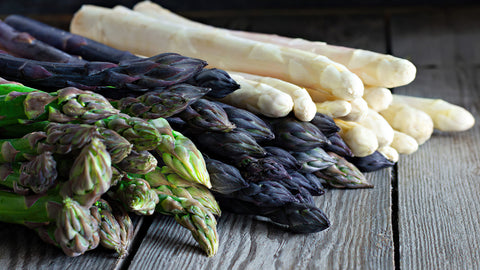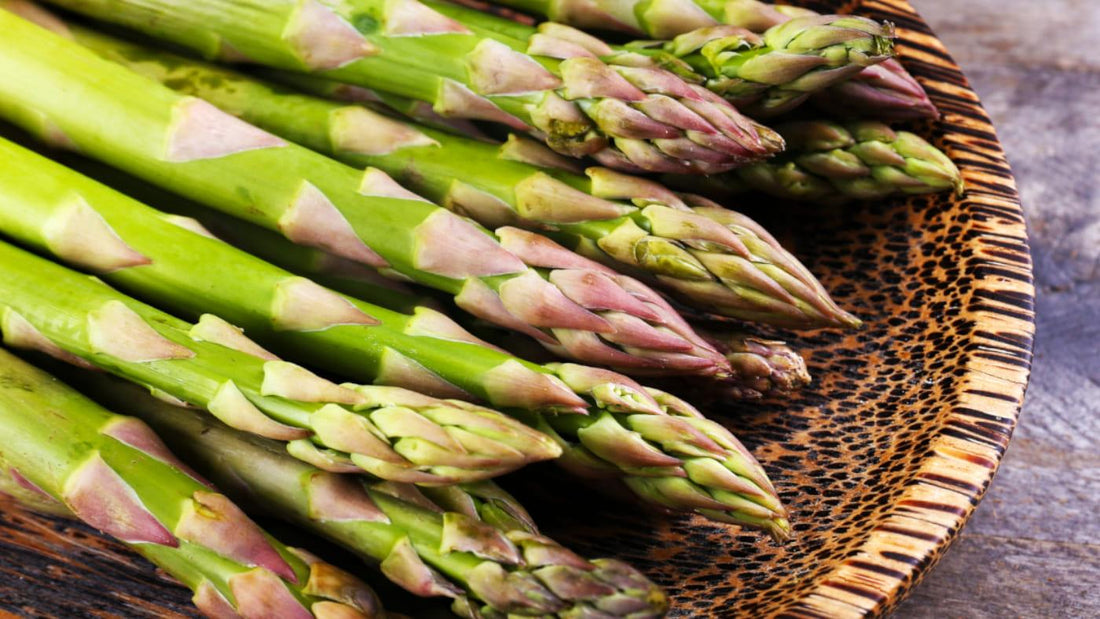The three basic types of this nutrient-rich vegetable have been staples of epicurean cuisine for more than 5,000 years. Since its initial discovery, asparagus has been prized for its tender stalk and soft bud and has been selectively bred to have the qualities and variations we know today.
Asparagus is known for its accommodating flavor and amazing health benefits and can be used both nutritionally and medicinally. The plant’s roots and seeds have been used to make medicine for about 2,000 years due to its laxative and contraceptive effects.
History of Asparagus
It was a popular medicinal crop in ancient Rome, Greece, and Egypt, and even played a part in ancient religious belief — asparagus was offered up to Egyptian gods as a sacrifice and was believed to be sacred by the Greeks.

Today, asparagus is one of the most popular vegetables in the US, and continues to lend itself to a wide range of recipes. It’s a vegetable that has taken its place among broccoli and leafy greens as a superfood.
However, asparagus has a reputation of being a high-end vegetable because of how pricey it can be. A crop of asparagus can take up to three years for its first harvest, meaning farmers sometimes have no choice but to hike up their price to make a profit.
Even so, there’s no doubt that asparagus is one of the most versatile vegetables out there. Let’s get into the health benefits of this superfood.
The Top Health Benefits of Asparagus
Asparagus is low in calories
Asparagus isn’t called a superfood for nothing — half a cup of fresh asparagus contains only 14 calories and is chock-full of nutrients.
Asparagus is an excellent source of vitamin A (for vision and cell growth), vitamin C (for the immune system, healing, and body maintenance), and vitamin K (for strengthening bones and preventing blood clots).
Folate, a B-vitamin, is also found in asparagus. Folate is needed for red blood cell formation and overall cell health.

It’s mind-boggling to think about all the nutrients you get from a single serving of asparagus.
Basically, this vegetable has got you covered.
Asparagus supports the digestive system
Fiber is the part of plant-based foods that cannot be broken down by the body. They pass through the body undigested and are crucial for a healthy digestive system.
Asparagus is a fiber-rich vegetable that cleans your colon as you eat it. Just half a cup of asparagus contains 7%, or 1.8 grams, of your daily fiber needs.
As the asparagus’ fiber moves through your intestines, it acts as a sponge, cleaning out built-up bacteria and promoting healthy digestion. This can help with constipation and diarrhea, and even reduces your risk of developing colon cancer.

The fiber in asparagus also reduces the risk of high blood pressure, heart disease, and diabetes.
Asparagus can lower your blood pressure
Since half a cup of asparagus contains 6% of your daily potassium needs, you can use it as a tool for lowering high blood pressure.
Potassium relaxes blood vessel walls, making it easier for blood to make its way through your body. Relaxing your blood vessels, as well as reducing your salt intake, is key to lowering your blood pressure.
The potassium in asparagus promotes kidney health as well, strengthening the kidney’s blood vessels and allowing for proper blood flow.
Buying Asparagus: What to Look For
Asparagus is shipped worldwide mainly from crops in China, Peru, Germany, and the US. Within the states, Michigan, California, Washington, and New Jersey are its biggest producers.
Asparagus is a hardy vegetable that can grow almost anywhere, tolerating temperatures between -40°F and 115°F, so there are plenty of places to get this tender vegetable from. But, if possible, locally sourced produce should always be your go-to. Buying locally supports your local farmers and can help reduce the emission of fossil fuels from national and international produce shipments.
There are three types of asparagus commonly found in supermarkets in the US — green, white, and purple. Before you buy your asparagus, make sure you know which one your recipe calls for.

The differences between green, white, and purple asparagus are minor, but can make all the difference to your recipe
Green asparagus is known for its grassy, woody flavor. It’s the most robust of the three, and also the most common.
White asparagus comes from the same seeds as green asparagus but is kept buried as it grows. Without access to sunlight, the asparagus never develops any color. The process of keeping the plant buried makes growing white asparagus more labor intensive — that’s why white asparagus is usually more expensive.
It’s flavor, while very similar to green asparagus, is sweeter and more delicate. It’s a delicate food that has to be cooked with care and are almost exactly the same. The difference between them is the way they’re grown. White asparagus is grown completely covered in dirt, blocking it from the sun to keep it white. When asparagus grows exposed to sunlight, it turns green.

White asparagus also contains more natural sugars than its green counterpart, and has a more bitter, yet delicate flavor that is highly prized in England.
Purple asparagus has a mild, sweet, and nutty flavor that green and white asparagus lack. If you’re wondering how it gets its color, this type of asparagus is selectively bred for its eye-catching color.
Which type of asparagus you choose, make sure the bundle you use is straight, firm, and has a closed tip.
Use your asparagus within 2 days of purchase for the best results, and make sure to store it in the fridge.
Cooking With Asparagus

Before cooking asparagus, you’ll have to snap off the bottom ends first. These ends are what give asparagus its woody flavor which can become overwhelming if you’re not careful. Break or cut about 1-2 inches off the bottom to be safe.
The bottoms of asparagus are also the most tough and stringy part of the vegetable. If you forget to remove these before cooking, you’ll have a very chewy side dish on your hands.
There are dozens of ways to cook asparagus — boiled, roasted, grilled, fried, steamed, and blanched to name a few. You can even cook them in the microwave. But if you’re looking for the healthiest way to prepare asparagus, sauté them.

Melt some butter or oil in a pan over medium heat and add in your prepared asparagus. Add in garlic and salt and pepper, or whatever other add-ins you’re in the mood for, and cook for about 6 minutes, or until tender.
Sauteed asparagus is a side dish that pairs perfectly with salmon, tuna, crab, and chicken dishes. It’s also great in pasta!

